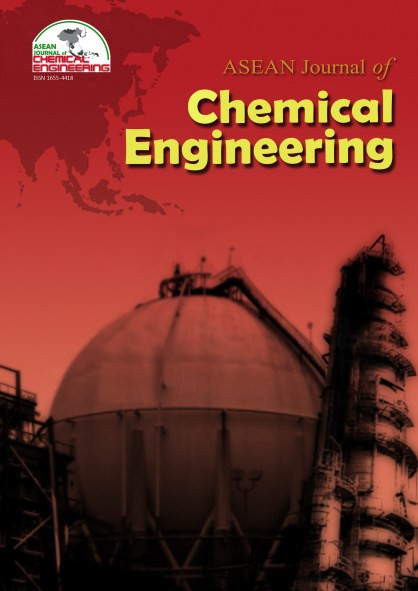Analysis of Control Valves Stiction Quantification Tool
Abstract
Control valve stiction is considered as one of the main sources of control loops nonlinearities which impacts plants profitability. In turn, this phenomenon hinders the plant from being operated at optimal conditions. Therefore, an efficient and accurate stiction quantification algorithm is required for accurate stiction compensation and timely scheduling of control valve maintenance. This research investigates the robustness and recommends improvements to the previously developed stiction quantification approach by Zabiri et al. The approach was tested under several operating conditions which were simulated in five case studies by using MATLAB software. The case studies investigated the impact of a wide range of stiction values, controller tuning, disturbance, time delay and noise on the quantification approach. The algorithm was found to be robust since it quantified the correct values of stiction regardless of the operating conditions. It was found that the accuracy of the quantification results depends on the process model accuracy, number of data samples and the search resolution. A number of improvements were recommended and validated by simulation in order to further enhance the current quantification approach. As conclusion, the algorithm can be applied on any type of process due to its robustness.
References
2. Ana S.R. Brásio, Romanenko Andry and Natércia C.P. Fernandes. (2014). Modeling, detection and quantification, and compensation of stiction in control loops: the state of the art. J. Ind. Eng. Chem. Res., 53, pp. 15020-15040
3. Bedoui, H., Khedher, A., Othman, K.B. (2014). “Fault detection and isolation of fuzzy system with uncertain parameters using the bounded approach”, WSEAS Trans. Syst. Control, 9, pp. 269-276.
4. Claudio Scali, Emanuele Matteucci, Daniela Pestonesi, Antonino Zizzo, and Evaldo Bartaloni. (2011). “Experimental characterization and diagnosis of different problems in control valves,” XVII Int. Federation of Automatic Control World Congr., pp. 7334-7339.
5. Control Valve Handbook. (2005). 4th ed., Fisher Controls International LLC Marshalltown, IA,. pp. 1-4, 67-74.
6. Dale E. Seborg, Thomas F. Edgar Duncan A. Mellichamp and Francis J. Doyle III. (2011). “Control system instrumentation” in Process Dynamics and Control, 3rd ed. New Jersey: Wiley, pp. 147-151.
7. Zabiri, H., Maulud, A. and Omar, N. (2009). “NN-based algorithm for control valve stiction quantification,” WSEAS Trans. Syst. Control, vol.4, pp. 88-97,.
8. Zabiri, H. and Yudi Samyudia. (2006). “A hybrid formulation and design of model predictive control for systems under actuator saturation and backlash,” J. Process Control, vol.16.7, pp. 693-709.
9. Zabiri, H., Ramasamy, M. and Tehv, I.S.Y. (2009). “Quantification analysis for NLPCA-based stiction diagnostic tool,” in Int. Conf. on Advanced Computer Control, pp. 468-472.
10. Beall, J. (2010). “Improving control valve performance,” Emerson Process Management Corp., Austin, TX, Tech. Rep. 117(10), Aug.
11. Shoukat Choudhury, M.A.A., Maridul Jain and Shah, S.L. (2008). “Stiction – definition, modelling, detection and quantification,” J. Process Control, vol. 18.3-4, pp. 232-243.
12. Shoukat Choudhury, M.A.A., Thornhill, N.F. and Shah, S.L. (2005). "Modelling valve stiction," J. Control Engineering Practice, vol.13.5, pp. 641-58.
13. M.A.A. Shoukat Choudhury, Sirish L. Shah, Nina F. Thornhill and David S. Shook. “Automatic detection and quantification of stiction in control valves,” J. Control Engineering Practice, vol.14, pp. 1395-1412, 2006.
14. Shoukat Choudhury, M.A.A., Shah, S.L. and Thornhill, N.F. (2010). “Diagnosis of poor control-loop performance using higher-order statistics,” J. Automatica, vol.40.10, pp. 1719-1728.
15. Manabu Kanu, Hiroshi Maruta, Hidekazu Kugemoto, and Keiko Shimizu. (2004). “Practical model and detection algorithm for valve stiction,” in Int. Federation of Automatic Control Symp. on dynamics and control of process systems, pp. 5-7.
16. Mohieddine Jelali and Biao Huang. (2010). Detection and diagnosis of stiction in control loops: state of the art and advanced methods. [Online]. Available: http://link.springer.com/chapter/10.10 07/978-1-84882-775-2_2
17. Bacci di Capaci, R., Scali, C., Pestonesi, D. and Bartaloni, E. (2013). “Advanced diagnosis of control loops: Experimentation on pilot plant and validation on industrial scale,” Int. Federation of Automatic Control Symp. on dynamics and control of process systems, pp. 589-594.
18. Bacci di Capaci, R. and Scali, C. (2015). “Review on Valve Stiction. Part I: From Modeling to Smart Diagnosis,” J. Processes, vol. 3(2), pp. 422-45.
19. Shardt, Y., Zhao, Y., Qi, F., Lee, K., Yu, X., Huang, B. and Shah, S. (2012). “Determining the state of a process control system: Current trends and future challenges,” J. Process Control, vol. 90(2), pp. 217-245.
Copyright holder for articles is ASEAN Journal of Chemical Engineering. Articles published in ASEAN J. Chem. Eng. are distributed under a Creative Commons Attribution-NonCommercial 4.0 International (CC BY-NC 4.0) license.
Authors agree to transfer all copyright rights in and to the above work to the ASEAN Journal of Chemical Engineering Editorial Board so that the Editorial Board shall have the right to publish the work for non-profit use in any media or form. In return, authors retain: (1) all proprietary rights other than copyright; (2) re-use of all or part of the above paper in their other work; (3) right to reproduce or authorize others to reproduce the above paper for authors’ personal use or for company use if the source and the journal copyright notice is indicated, and if the reproduction is not made for the purpose of sale.


